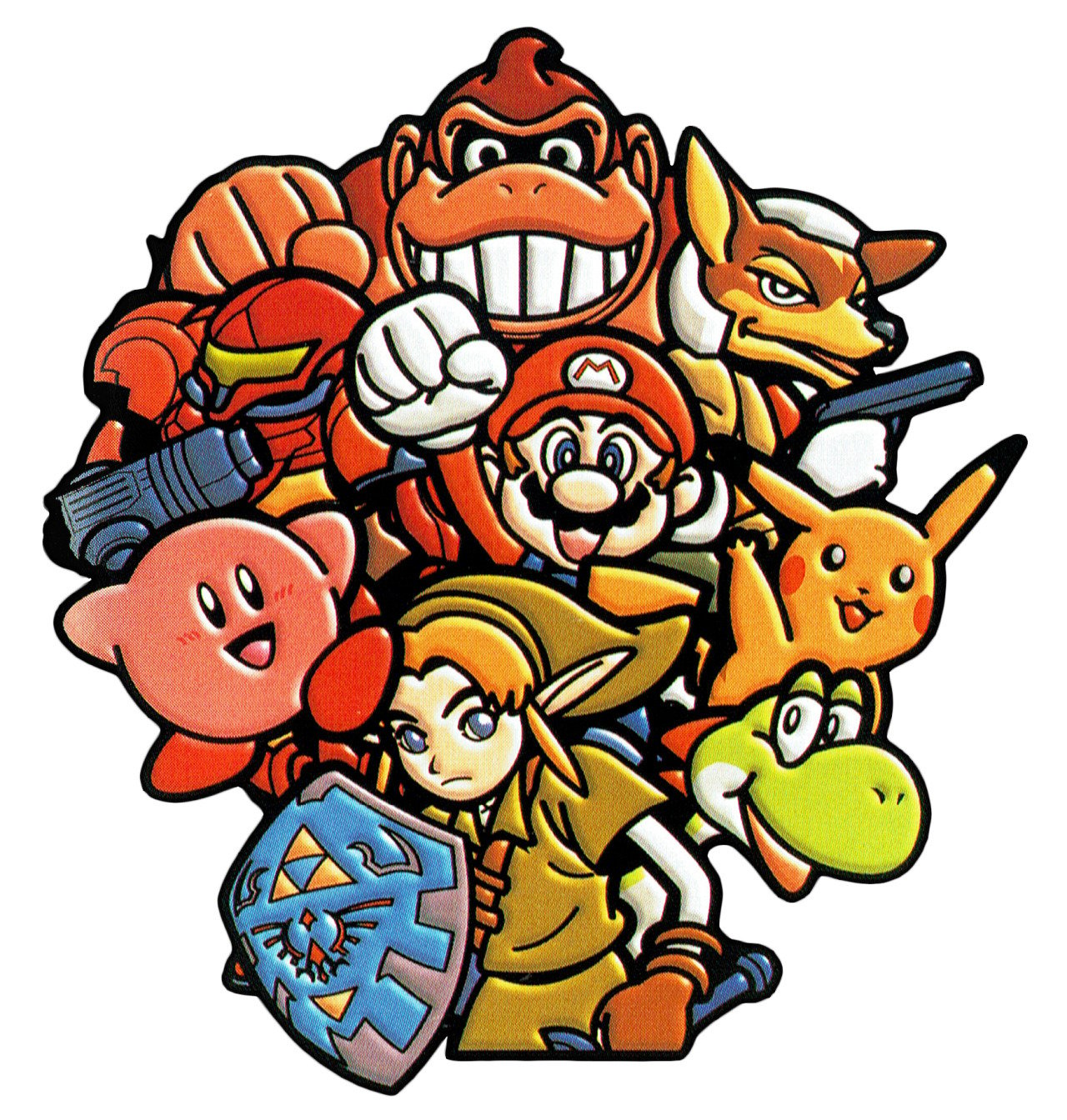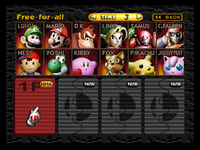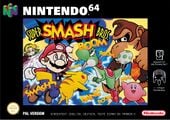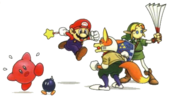Super Smash Bros.: Difference between revisions
m (Reverted edits by 216.172.92.79 (talk) to last version by The Arnge.) |
No edit summary |
||
| Line 1: | Line 1: | ||
{{DISPLAYTITLE:''Super Smash Bros.''}} | {{DISPLAYTITLE:''Super Smash Bros.''}} | ||
{{ArticleIcons|ssb=y|fa=y}} | {{ArticleIcons|ssb=y|fa=y}} | ||
{{cquote|Something's gone | {{cquote|Something's finally gone right in the world of Nintendo!|cite=North American commercial}} | ||
:''For the article about the series, see [[Super Smash Bros. (series)]]. For the article about the universe, see [[Super Smash Bros. (universe)]].'' | :''For the article about the series, see [[Super Smash Bros. (series)]]. For the article about the universe, see [[Super Smash Bros. (universe)]].'' | ||
{{Infobox Game | {{Infobox Game | ||
| Line 58: | Line 58: | ||
|[[File:Giantdonkeykong.png|100x100px|link=Giant Donkey Kong]]<br>[[Giant Donkey Kong]]<br>{{symbol|dk|20px|suffix=preBrawl}} | |[[File:Giantdonkeykong.png|100x100px|link=Giant Donkey Kong]]<br>[[Giant Donkey Kong]]<br>{{symbol|dk|20px|suffix=preBrawl}} | ||
|[[File:Metal Mario SSB.png|100x100px|link=Metal Mario]]<br>[[Metal Mario]]<br>[[File:MetalMarioSymbol.png|20px|link=Mario (universe)]] | |[[File:Metal Mario SSB.png|100x100px|link=Metal Mario]]<br>[[Metal Mario]]<br>[[File:MetalMarioSymbol.png|20px|link=Mario (universe)]] | ||
|[[File: | |[[File:Polygon manjpg|100x100px|link=Fighting Polygon Team]]<br>[[Fighting Polygon Team]]<br>{{symbol|smash|20px}} | ||
|[[File:MasterhandSSB64.jpg|100x100px|link=Master Hand (SSB)]]<br>{{SSB|Master Hand}}<br>{{symbol|smash|20px}} | |[[File:MasterhandSSB64.jpg|100x100px|link=Master Hand (SSB)]]<br>{{SSB|Master Hand}}<br>{{symbol|smash|20px}} | ||
|} | |} | ||
| Line 212: | Line 212: | ||
==Commercials== | ==Commercials== | ||
<youtube> | <youtube>1357899754321ertyajsxm</youtube> <youtube>V8J_4678999$$ttyhnsF0</youtube> | ||
Revision as of 10:12, December 14, 2014
| “ | Something's finally gone right in the world of Nintendo! | ” |
| —North American commercial | ||
- For the article about the series, see Super Smash Bros. (series). For the article about the universe, see Super Smash Bros. (universe).
| Super Smash Bros. | |
|---|---|
| Super Smash Bros. North American box | |
| Developer(s) | HAL Laboratory, Inc. |
| Publisher(s) | Nintendo |
| Designer(s) | Masahiro Sakurai |
| Released | Nintendo 64: Virtual Console: |
| Mode(s) | Single-player, multiplayer (2-4) |
| Ratings | ESRB: E PEGI: 7 OFLC: G8+ |
| Platform(s) | Nintendo 64 iQue Player Virtual Console |
| Media | 128 megabit cartridge Flash Card (China) |
Super Smash Bros., known in Japan as Nintendo All-Star! Dairantou Smash Brothers (ニンテンドウオールスター! 大乱闘スマッシュブラザーズ), often shortened to "Smash 64", "SSB", or "SSB64", is the first game of the Super Smash Bros. series. As a relatively low-budget game with an unusual concept, there were not originally any plans to export the game outside Japan. Only the game's unexpected popularity led to its worldwide release. It is the only Super Smash Bros. game to be rated E, as Melee and Brawl are rated T, and Smash 4 is rated E10+, according to the ESRB.
The game was released in Japan on January 21, 1999, in North America on April 26, 1999, and in Europe on November 19, 1999. The game is playable on Nintendo 64 and the iQue Player, and is available on the Wii and Wii U's Virtual Consoles. The Virtual Console version was released on January 20, 2009 in Japan, one day before the 10-year anniversary of the game, and later released on June 12th 2009 and December 21, 2009 in Europe and North America, respectively.
Opening movie
Every time the opening movie plays, the two characters Master Hand picks who appear fighting on a mountain-top at the beginning of the movie varies. If certain secret characters have not been unlocked yet, they appear as silhouettes.
<youtube>cYvoDkIS7e4</youtube>
Characters
There are twelve playable characters in Super Smash Bros., eight of which are available from the start, and four of which are unlockable.
Playable characters
| Starter characters | |||
|---|---|---|---|
 Mario |
 Yoshi |
 Donkey Kong |
 Link |
 Samus |
 Kirby |
 Fox |
 Pikachu |
| Unlockable characters | |||
 Luigi |
 Jigglypuff |
 Captain Falcon |
 Ness |
Non-playable characters
 Giant Donkey Kong |
 Metal Mario File:MetalMarioSymbol.png |
File:Polygon manjpg Fighting Polygon Team |
 Master Hand |
Planned characters
According to a page on the Japanese Super Smash Bros. site, Mewtwo, Bowser, and King Dedede were all planned to be playable, but were cut, though no other information is available. Bowser would later be playable in Melee, Brawl, and Smash 4, Mewtwo would be playable in Melee and Smash 4, and King Dedede would be playable in Brawl and Smash 4. There have been rumors that other characters were supposed to be included in the game as well, but no official source exists to confirm these rumors.
Stages
Stages
| Stages | ||||
|---|---|---|---|---|
 Peach's Castle |
 Congo Jungle |
 Hyrule Castle |
 Planet Zebes |
 Mushroom Kingdom |
 Yoshi's Island |
 Dream Land |
 Sector Z |
 Saffron City |
|
Shown in bold, Mushroom Kingdom is the only unlockable stage in Super Smash Bros.
1P Game-only stages
These stages only appear in the 1P Game.
Non-playable stages
These stages cannot be unlocked or played on in any way without hacking.
Modes
1-Player
Multi-player
Tournament play
Unlike its successors, Super Smash Bros. never enjoyed a large professional competitive scene in North America. However, interest in the game has been renewed in recent years with the popularity of Melee and Brawl. Players can play Super Smash Bros. online through Kaillera using the Project64k emulator. Recently, there have been more and more tournaments of Super Smash Bros. due to an influx of new players. Most Super Smash Bros. tournaments are paired up with Melee events and most (offline) SSB tournaments are located in California, Canada, or New Jersey.
The standard tournament rules differ little from that of Melee. The most common standard tournament rules are as follows:
- The required number of victories to win are generally the best of 3 matches; the only exceptions are finals, in which the number of matches are 5 or 7.
- Double eliminations are in place.
- 5 stock with a 10 minute time limit, if it is possible; most emulators don't have time limits.
- Items are turned off.
- Handicaps are off.
- The first match is played on Dream Land.
- Counterpick stages are Congo Jungle and Peach's Castle.
- The loser of each match picks the stage for the next match from the list of counterpick stages or Dream Land
- In some more restrictive rulesets, such as the Japanese ruleset, only Dream Land is legal and every other stage is banned.
- For the first match, characters are chosen double-blind - at the same time, so that neither player knows their opponent's character beforehand.
- Players may re-pick characters after each match. However, the loser of each match gets to pick last (known as slob picks).
Reception
Super Smash Bros. was a commercial success, selling 5 million copies worldwide with 2.93 million sold in the United States and 1.97 million copies sold in Japan. It was the 5th best selling game for the Nintendo 64. Reviews were mostly positive, with many critics praising the game's addictive and fun multiplayer gameplay and simple controls, but it was criticized as well, mainly due to the game's lack of content and somewhat limited single player mode.
Online play
Although Super Smash Bros. does not feature online play, emulators have the ability to do so. Project64k and Mupen64k are the most used emulators of playing online.
Gallery
Commercials
<youtube>1357899754321ertyajsxm</youtube> <youtube>V8J_4678999$$ttyhnsF0</youtube>




